“.......Pleasure is spread through the earth, In stray gifts to be claimed by whoever shall find”
William Wordsworth
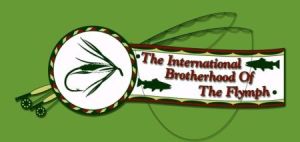
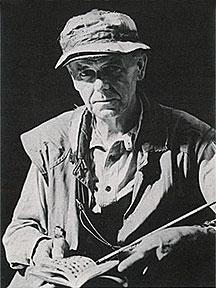
“ We fish for pleasure; I for Mine, you for yours” Leisenring’s Notebooks
See also FlymphForum.com
Allen McGee
You must tie your fly and fish your fly so the trout can enjoy and appreciate it”
-James Leisenring
Modern fly anglers recognize the importance of fishing sub-surface flies particularly nymphs to imitate immature aquatic invertebrates. While nymphing is often thought of as more difficult than dry fly fishing a skilled nymph fisherman can frequently catch more and particularly larger trout under a variety of water conditions day in and day out. The basic reason is that trout especially the largest and wisest ones prefer to feed primarily underwater where there are safer from predators and it’s more efficient for them to feed. 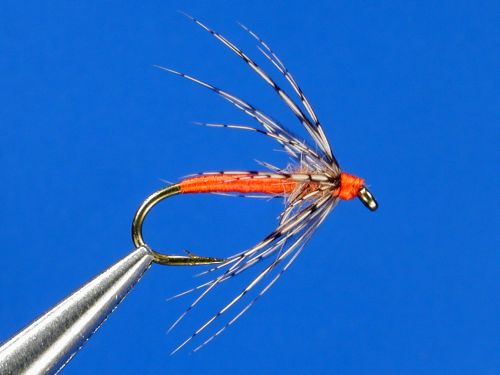
Partidge & Orange spider
Additionally, emergers, the transitional stage between nymph or pupa and adult, are of up most importance due to their vulnerability and availability, providing an efficient food source for trout. The North Country spiders of northern England were perhaps the first serious imitations of emergers and are still very effective even as emerger fly patterns become more and more realist in the modern era of fly fishing. However, many modern patterns, both nymphs and emergers, are often fished with a static approach. That is many anglers think they should only dead-drift their flies to rising or suspected trout feeding lies. While dead drifts can be a natural behavior for aquatic insects, anglers sometimes forget that trout key in on the most vulnerable stage and available location of the insect. This often is not on the surface but rather along the stream bed up to the surface as insects hatch and ascend either by floating buoyed by internal gases or with propulsion by abdominal muscular action. These movements attract the attention of fish and being that they happen underwater enable the trout to feed efficiently with more safety than if they were targeting floating targets. Anglers such as Stewart, Pritt, Edmunds, Lee, Skues, Sawyer, Leisenring, and Hidy recognized this and wrote of fly imitations and techniques that imitated sub-surface and transitional ascending nymphs and pupa. The North Country spiders of northern England and southern Scotland were some of the first soft-hackled fly imitations. Spiders imitate mayfly emergers, duns, and sometimes spinners and are sometimes without equal in their effectiveness but they are also historically used for surface film fishing. For deeper sub-surface presentations we use soft hackled nymphs (shn’s) and flymphs which are fished from the stream bottom up to the surface. While historically related to, and sometimes classified in with the soft hackled spiders, flymphs, or wingless wets as Leisenring called them, differ from spiders in a couple of major ways. First, compared to the spiders thin bodies and sparse hackle collars, flymphs have bulkier, fuzzy bodies made of fur spun between silk or thread. Flymph hackle collars are often fuller as well and can be tied in at the hook eye, at the thorax point, or even palmered from mid-body up to the hook eye giving the impression of much more movement in the hackle. Overall flymphs are much meatier. Furthermore, flymphs are designed to be fished underwater, fully wet, because they are imitations of ascending nymphs transitioning into adults.
Vernon S. “Pete” Hidy coined the term flymph. What is a flymph? A flymph is a hatching insect be it mayfly, caddisfly, midge, or stonefly that according to Pete Hidy is in the stage of metamorphosis “changing from wingless nymphs to flies with wings”. These flies are historically fished with a across and downstream technique that allows the current to naturally swing and raise the fly up to the surface in front of a rising or holding fish in a manner that activates the soft hackle collar and body materials effectively imitating life in the ascending artificial fly. The attraction of these flies is that not only do they look natural but they behave natural as well. They have movement; they have the appearance of life.
Real nymphs don’t roll over as they drift in the stream but a fly tied on a tippet will twist and turn. Thus as flymphs and shn’s are usually “tied in the round”, meaning they don’t have a designated top or bottom, they look more natural to trout. A fly that is tied with a designated back such as a wingcase and underside can look fake if it rides upside down as this is a very un-natural position, one that can cause fish to refuse to strike out of suspicion.
Traditionally flymphs are tied with natural body materials that will undulate in the currents. These body materials include hare’s mask, peacock, muskrat, mole, squirrel, and other natural fur with guard hairs. Shaggy body materials like rabbit, hare, and squirrel hold water well, sink quickly and also capture small air bubbles when they penetrate the surface film. These air bubbles create shimmer and sheen and look particularly similar to caddis pupa which uses internal gases to propel them to the surface or egg-laying caddis that dive underwater to lay eggs and carry with them oxygen bubbles for respiration. The hackle collars of flymphs are chosen with color and movement in mind to match the emerging wings, antennae, and legs of the ascending nymph. Soft, webby feathers such as hen, partridge, grouse, starling, woodcock, or quail are choice. These feathers absorb water and each has it own unique action underwater.
Some modern flymphs are even tied with bodies representing both nymphal and adult components. For instance, the Transition Flymph is tied with a natural pheasant tail abdomen and a rabbit fur thorax of the shade of the emerging body of the adult mayfly. Furthermore, a Z-Lon shuck can be added giving the appearance of the nymph shedding its exoskeleton on its way to the surface. 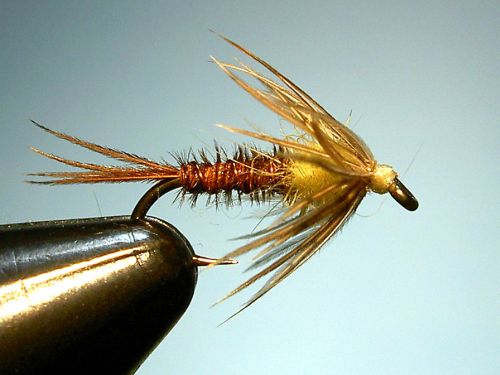
McGee’s Transition Flymph
While un-weighted flymphs are used to fish anywhere from shallow stream bottoms to the surface, shn’s (soft-hackled nymphs) are used for imitating immature nymphs living on the stream bed. Why use shn’s instead of the common artificial nymph patterns you fly find in today’s flyshops? Because they have more “action and attraction” than standard nymphs due primarily to the soft hackle collars. Leisenring called them “short-hackled thorax nymphs” and they can be fished dead drift with mends, high-sticked, or with line manipulation techniques to imitate a swimming nymph. SHN’s can be fished un-weighted, with split shot, or with weight such a lead underbodies or even glass, copper, or tungsten beads to help them achieve a bottom roll and stay submerged.
Tracing the history of soft hackles goes back to the beginning of written fly fishing history.In 1425 Dame Juliana Berner wrote The Treatyse of Fysshynge wyth an Angle.In this book there is documentation of the “donne fly”. Historians believe this to be what we now call the Partridge & Orange .
In 1857 W.C. Stewart was one of the first to describe in detail the North Country Spiders of northern England and southern Scotland in his book The Practical Angler. Stewart was the first to fully present these pattern recipes in documented form. He wrote of the Dun Spider, the Black Spider, and the Red Spider giving dressing information and fishing technique lessons. The North Country spiders were invented by the northern spate stream fishermen because the dry flies of their time were not as effective on their more turbulent streams were trout didn’t rise as freely as on the placid chalk streams of southern England. These first soft hackled spiders were fished in the surface film to imitate emergers and even more effectively fished sub-surface where the majority of these fish fed. Later the spiders would be further investigated by T.E. Pritt, N.N. Lee, H.H. Edmonds, Hohn Jackson and others.
Throughout the 1800’s soft hackled spiders gained acceptance and popularity. T.E. Pritt wrote Yorkshire Flies 1885 and North Country Flies 1886, and in 1916 H.H. Edmonds and N.N. Lee’s Brook and River Trouting helped introduce anglers to these flies and techniques. Yet still, on the chalk streams of southern England soft hackles received a less than inviting acceptance. Many of these club fishermen refused to fish and even ruled out anything but high floating dry flies. But one fly fisherman who observed the importance of nymphs and began imitating them was G.E.M. Skues. At first Skues quietly went about adapting his dry flies to sub-surface usage. Then he began innovating nymph patterns. While his 1910 book Minor Tactics of the Chalk Stream,entitled so as not to offend his fellow club anglers who all subscribed to the dry fly school of thought, discussed sub-surface techniques it was his 1921 book The Way of a Trout with a Fly that really discussed what we know today as modern nymphing using artificials tied precisely to imitate nymphal mayflies. Skues named the flies described in this book “soft-hackled thorax nymphs”. Even today these flies are strikingly familiar and could be considered flymphs and shn’s. James Leisenring would be heavily influenced Skues’ patterns and fishing methods. Leisenring even named his nymphs “short-hackled thorax nymphs”. Because of Skues nymph fishing slowly began to gain wider acceptance.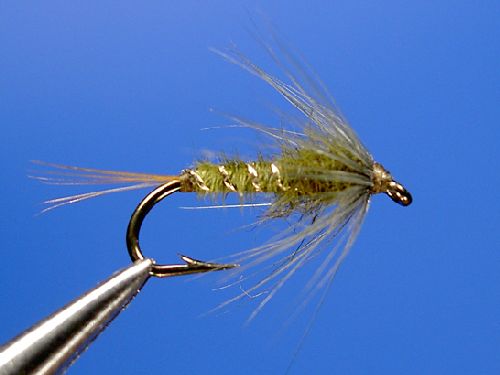
G.E.M. Skues Medium Olive Nymph
James Leisenring and Vernon S. “Pete” Hidy would write what was arguably the next revolutionary soft hackled nymph book. In 1941 they collaborated on The Art of Tying the Wet Fly which is now considered the landmark work on soft hackled nymphs. “Big Jim” Leisenring lived in Allentown, Pennsylvania were he honed his wet fly fishing skills on Broadhead Creek and the Little Lehigh. Pete Hidy met Leisenring on-stream where he first eye-witnessed Leisenring skills with the wet fly. Leisenring taught Hidy how to tie and fish these patterns and eventually they published The Art of Tying the Wet Fly with Hidy writing the text. Other students of Leisenring included Dick Clark and Chip Stauffer who taught Leisenring’s tactics to many anglers including Art Flick who learned and fished them on Schoharie Creek in the New York Catskill’s.
James Leisenring stressed the body in his wet flies. By using silk and natural fur he created a two-tone hue to his fly’s bodies. This creates a translucent effect quite similar to the naturals whose adult inner bodies show through the nymphal exoskeletons. He built his fly bodies by rolling the fur between a doubled over silk thread held on top of his thigh while seated. Later Pete Hidy employed the Clark spinning block to fashion the bodies which was easier. The bodies were then stored on pre-labeled cardboard cards so that they could be quickly chosen and tied into the fly. The soft hackle collar adds to the fly’s attraction with enticing movements created by the current which further brings the fly to life
.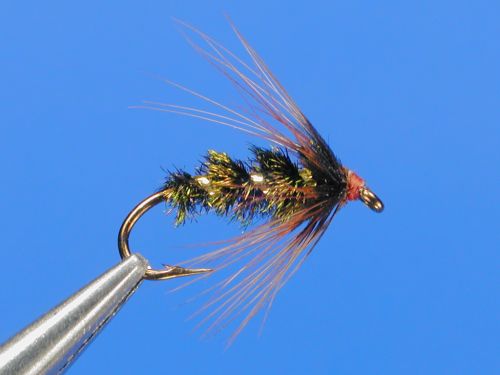
James Leisenring’s Brown Hackle.
One of the most commonly known fishing techniques for flymphs is called the Leisenring Lift. While certainly not the only one Jim used this method is very effective in imitating a naturally ascending caddis pupa or mayfly nymph. According to Hidy, Leisenring used many other methods however they were not documented in the book.
Leisenring was known as “the American Skues”. And while he was relatively well known in the United States at this time he was well recognized for his talents by the English anglers as Skues had presented Leisenring’s flies and techniques to the Fly Fisher’s Club of London. One reason that Leisenring never became really well known to anglers was that his book was written during World War II when the minds of many were focused on winning the war. While the knowledge of Leisenring’s importance to wet fly fishing has increased there are still many who can learn from his strategies.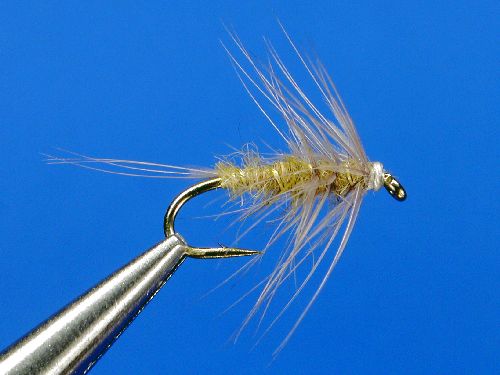
Little Olive Flymph - palmered hackle
Vernon S. Hidy was born in Ohio but moved to Pennsylvania after college. It was here that “Pete” as he was known by his friends met James Leisenring. When Hidy was only 27 he and Leisenring collaborated on The Art of Tying the Wet Fly. This book detailed the Leisenring style of wet fly nymph fishing and while the term “flymph” never appeared in the early version these flies were flymphs and shn’s. One of the biggest revelations that Leisenring related in this book was that he felt that wingless wets, i.e. flymphs, were more effective than winged wet flies. This is due to the fact that Leisenring fished them as nymphs and emerger imitations and as such they shouldn’t have had thick, bulky wings as many wet flies do. Wingless wet flies imitate these nymphal and transitional life stages more naturally than winged wets and thus are more attractive to the fish. After Leisenring’s death in 1951 Pete Hidy kept fishing and writing about wet flies or as he called them “flymphs”. In 1960 he wrote the book Sports Illustrated Wet Fly Fishing, which was another valuable contribution to angling. Then in 1971 he updated and expanded The Art of Tying the Wet Fly and Fishing the Flymph. This was the first time the word “flymph” had entered the vernacular of the fly fishing community. The new edition of the book had three fresh chapters added to the 1941 printing. These innovative chapters explored Hidy’s own experiences with fishing flymphs. Also in 1971 he wrote two articles on flymphs for Fly Fisherman magazine. 1972 saw Hidy publish another book, Sports Illustrated Fly Fishing. Then in 1979 Hidy summed up his fishing philosophy with the chapter entitled “Soft-hackle Nymphs-the Flymphs” in the book The Masters on the Nymph. This chapter really describes flymphs well and is worth the price of the book alone. Pete Hidy can be considered the heir to Skues and Leisenring. He contributed many fine books and ideas to wet fly fishing and of course penned the term “flymph” to describe these transitional wet fly patterns. In effect he preserved the tradition of wingless wet fly fishing by bringing it into modern fly angling practice.
In 1975 Sylvester Nemes began the re-introduction of sorts to traditional North Country spider patterns, including Pritts original North Country spiders, with the book The Soft-Hackled Fly. This book along with a string of others have kept traditional soft hackled spider patterns alive and well in the fly fishing community while introducing some innovative patterns to a new generation of fly anglers. Nemes’s other books include The Soft-Hackled Fly Addict (1981), Soft-Hackled Fly Imitations (1991) The Soft-Hackled Fly: A Trout Fisherman’s Guide (1993), Spinners (1995), and Two Centuries of Soft Hackled Flies (2004).
Most recently Dave Hughes, who knew Pete Hidy, has kept the tradition of flymphs alive. In 1994 he wrote Wet Flies: Tying and Fishing Soft-Hackles, Winged and Wingless Wets, and Fuzzy Nymphs. This book has detailed descriptions of how to tie and fish fly patterns from Leisenring, Hidy, and Polly Rosborough.
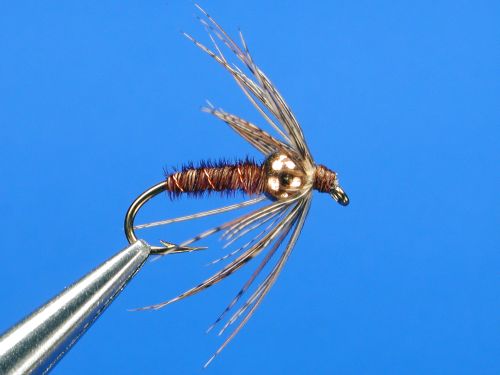
Pheasant Tail SHN – Metal Bead Thorax
Despite the long tradition they enjoy spiders, flymphs and shn’s have remained relatively little known or at least mis-understood by many anglers. But these flies and the literature that surrounds them are masterpieces and are as effective today as ever. These flies have survived even in their relative anonymity among the general fly fishing community because look so alive and will work when other flies fall short. Leisenring said, "We all fish for our own enjoyment - me for mine and you for yours", meaning there is no right or wrong in how each of us fishes. Of course at times some flies work better than others, the same with technique but I feel that if Skues, Leisenring and other wet fly pioneers were alive today they would still be furthering and developing their fly patterns and fishing methods. As well today’s wet fly anglers should continue to develop new and innovative patterns and techniques for fishing them while keeping in mind the lessons that we have been provided on flymphs and shn’s. It’s important to recognize that new materials can further enhance the liveliness and effectiveness of flymphs while still embracing the past and using time tested materials. Some of the new materials that work well being incorporated into flymphs and shn’s are Z-Lon, genetic hen saddles, glass, metal, and tungsten beads, ostrich herl, and even cdc. These add attraction and follow the intentions of the original flymph idea which is to simulate life and movement in a transitional artificial fly. The International Brotherhood of the Flymph is dedicated to the preserving the history and future of wet fly fishing. Just as the North Country spiders eventually led to the “soft-hackled thorax nymphs” of G.E.M. Skues which later influenced Liesenring and Hidy we can incorporate shn’s and flymphs, both old and new, into modern fly fishing. These flies and their methods are just too effective to forget. The future is the flymph and variations of such.
Allen McGee
2005
Selected Wet Fly Literature:
W.C. Stewart’s The Practical Angler, 1857
T.E. Pritt Yorkshire Flies, 1885 and North Country Flies, 1886
H.H. Edmonds and N.N. Lee's Brook and River Trouting, 1916
G.E.M. Skues The Way of a Trout with a Fly, 1921
G.E.M. Skues Nymph Fishing For Chalk Stream Trout, 1939
James Leisenring and Vernon Hidy The Art of Tying the Wet Fly, 1941
James Leisenring and Vernon Hidy The Art of Tying the Wet Fly and Fishing the
Flymph, 1971
Vernon Hidy Sports Illustrated Wet Fly Fishing, 1961
Vernon Hidy Sports Illustrated Fly Fishing, 1972
Vernon Hidy The Art of Fishing the Flymph – Pt. I The Flymph Phenomenon, Fly-Fisherman magazine, 1971
VernonHidy Fishing the Flymph - II The Dry Fly and the Flymph: A Parallel, Fly-Fisherman magazine, 1971
Vernon Hidy Soft-Hackled Nymphs-The Flymphs chapter in The Masters on the Nymph, 1979
Sylvester Nemes The Soft-Hackled Fly, 1975
Sylvester Nemes The Soft-Hackled Fly Addict, 1981
Sylvester Nemes Soft-Hackled Fly Imitations, 1991
Sylvester Nemes The Soft-Hackled Fly: A Trout Fisherman’s Guide, 1993
Sylvester Nemes Spinners, 1995
Sylvester Nemes Two Centuries of Soft Hackled Flies, 2004
Dave Hughes Wet Flies – Tying and Fishing Soft-Hackles, Winged and Wingless Wets, and Fuzzy Nymphs, 1995
Allen McGee Soft-Hackled Nymphs due out in 2005
See also FlymphForum.com